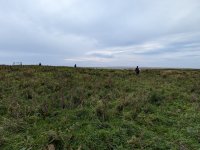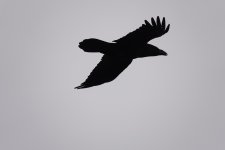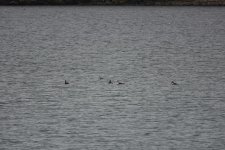Hotspur
James Spencer

After 18 months of procrastinating, Peter Williams, Nick Morgan and I headed to Stronsay in early October 2024. Here is the first of daily posts covering our efforts. It is written as a day by day diary, so (hopefully) there will be a big bird with no real build up, however in all likelihood we will just have a nice time. I'll add photos when I can.
We travelled from Yorkshire to Thurso on October 4th, and birding was done purely from the car due to the need to get up to the top of Scotland. Highlights were limited to Red Kite on the A66 and that was about it. We made excellent progress and after a dinner stop in Inverness, we arrived at Thurso at 21:30 exhausted but elated to have done the hardest bit of the journey.
Premier inn is many things but all three of us suffered a fitful nights sleep, and the anticlimax of a continental breakfast left us disappointed. Something that was far from disappointing was the view from the car as we sped towards the Pentland Ferry. Hooded Crows and views of sites we had only heard of were exciting, as were the skeins of Pink-footed geese. A few gannets and rock pipits were the highlights as odd lapwings flew onto the mainland from Orkney. The crossing started with a few Harbour Porpoises feeding in Gills Bay, with the trips first Tystie plus Guillemots and Razorbills. It was incredibly calm for the Pentland Firth, and relatively few birds were seen with handfuls of Kittiwakes and auks. A super brief Minke Whale was seen badly by Dan, a birder heading to North Ron, and I, disappearing before Nick and Pete could get onto it. Before long we were docking at South Ron, my first visit.
The island was bathed in sun and we whizzed round to Honeysgeo. Here the habitat looked incredible, as we bumped into a flock of 200 golden plover. Attempting to grill them for the hoped for Yank was put paid to by a keen female Sparrowhawk, which sent them to the horizon. A few other common waders bobbed about. It was far too nice, and far too calm, and the gardens produced just a couple of blackbirds, and a Moorhen which looked comical traversing the top of a hedge. We bumped into Steve Sankey and his partner out on their bikes which was nice to put a face to a name from the local WhatsApp group. Whilst chatting we had our first Hen Harrier working the fields.
Time marches ever on, and we soon moved to Echna Loch, where a party of 4 Long-tailed Ducks were in the bay, with 3 Slavonian Grebes and hordes of Eider and some Red-breasted Mergansers. We had seen plenty of the latter species as we came into dock but the former two were hoped for at this location, and the ducks looked very smart. The loch itself held Wigeon, Gadwall, Teal and a Little Grebe.
We pressed on before long to Loch of Ayre, where a scruffy drake Ring-necked Duck blended in with the locals. I wasn't particularly taken with this nearctic visitor but a nice to see. A late Arctic Tern was fishing out in the bay behind us, which was still looking pretty smart. I don't know how long they linger in the isles but not much longer I'd have thought.
Again, time was pressing, and we decamped towards Kirkwall to stock for supplies. A big group of Whoopers were seen on the waterbodies near Tesco as we armed with snacks. We arrived for the ferry early, and discussed the relative merits of the pigeons which looked less convincing in town than some of the others we had seen, with big ceres and various hues. To our delight, we loaded up, and set off 5 minutes early. Stronsay was still hidden but we were on the final leg.
Birds remained broadly similar on the crossing with more Tysties, and a couple of Red-throated Divers. A highlight was a moulting Great Northern Diver off Shapinsay. We saw handfuls of both species of seal on another calm passage. Once we cleared Shapinsay, a little swell developed as we were hit by the SSE breeze. All the while, an Orcadian backdrop scrolled past our vantagepoint on the starboard deck. Stronsay soon came into view and once in the islands waters we started the trip in earnest, firstly with some foraging Gannets.
The arrival into Whitehall was straightforward, although we were shadowed by leering wildflowers, getting excited by the clouds of geese over the airfield. Another Red-throated Diver was joined by further Black Guillemots as we passed the skeleton of a boat. Once docked, I took the executive decision to have a quick spin round the island in the remaining light. All manner of habitats had our respective appetites whetted, and we went out to Rothiesholm, checking Matpow and Bu Lochs. The latter bad 9 Black-tailed Godwits. A Rook was keeping company with a Hooded Crow which unbeknownst to us, was pretty decent, and our first ring-tail Hen Harrier on the island gave lovely views. We soon returned to Whitehall but not before Pete spotted a Northern Wheatear atop a hay bale. A taste of things to come? We certainly hoped so.
After checking into the Storehouse B&B, and receiving a warm welcome and a gladly received Steak Pie for tea, we met Jake and Drew in the pub. They had just done a week on the island and we were crossing over by a day, so it was time to get acquainted and talk details over a pint. We were accosted by a couple of well-oiled and well-meaning locals in a good natures chat, and were soon headed back to bed, heads filled with hope. Stronsay, in our short time already, looked spectacular.
Ebird trip report: https://ebird.org/tripreport/280423
We travelled from Yorkshire to Thurso on October 4th, and birding was done purely from the car due to the need to get up to the top of Scotland. Highlights were limited to Red Kite on the A66 and that was about it. We made excellent progress and after a dinner stop in Inverness, we arrived at Thurso at 21:30 exhausted but elated to have done the hardest bit of the journey.
Premier inn is many things but all three of us suffered a fitful nights sleep, and the anticlimax of a continental breakfast left us disappointed. Something that was far from disappointing was the view from the car as we sped towards the Pentland Ferry. Hooded Crows and views of sites we had only heard of were exciting, as were the skeins of Pink-footed geese. A few gannets and rock pipits were the highlights as odd lapwings flew onto the mainland from Orkney. The crossing started with a few Harbour Porpoises feeding in Gills Bay, with the trips first Tystie plus Guillemots and Razorbills. It was incredibly calm for the Pentland Firth, and relatively few birds were seen with handfuls of Kittiwakes and auks. A super brief Minke Whale was seen badly by Dan, a birder heading to North Ron, and I, disappearing before Nick and Pete could get onto it. Before long we were docking at South Ron, my first visit.
The island was bathed in sun and we whizzed round to Honeysgeo. Here the habitat looked incredible, as we bumped into a flock of 200 golden plover. Attempting to grill them for the hoped for Yank was put paid to by a keen female Sparrowhawk, which sent them to the horizon. A few other common waders bobbed about. It was far too nice, and far too calm, and the gardens produced just a couple of blackbirds, and a Moorhen which looked comical traversing the top of a hedge. We bumped into Steve Sankey and his partner out on their bikes which was nice to put a face to a name from the local WhatsApp group. Whilst chatting we had our first Hen Harrier working the fields.
Time marches ever on, and we soon moved to Echna Loch, where a party of 4 Long-tailed Ducks were in the bay, with 3 Slavonian Grebes and hordes of Eider and some Red-breasted Mergansers. We had seen plenty of the latter species as we came into dock but the former two were hoped for at this location, and the ducks looked very smart. The loch itself held Wigeon, Gadwall, Teal and a Little Grebe.
We pressed on before long to Loch of Ayre, where a scruffy drake Ring-necked Duck blended in with the locals. I wasn't particularly taken with this nearctic visitor but a nice to see. A late Arctic Tern was fishing out in the bay behind us, which was still looking pretty smart. I don't know how long they linger in the isles but not much longer I'd have thought.
Again, time was pressing, and we decamped towards Kirkwall to stock for supplies. A big group of Whoopers were seen on the waterbodies near Tesco as we armed with snacks. We arrived for the ferry early, and discussed the relative merits of the pigeons which looked less convincing in town than some of the others we had seen, with big ceres and various hues. To our delight, we loaded up, and set off 5 minutes early. Stronsay was still hidden but we were on the final leg.
Birds remained broadly similar on the crossing with more Tysties, and a couple of Red-throated Divers. A highlight was a moulting Great Northern Diver off Shapinsay. We saw handfuls of both species of seal on another calm passage. Once we cleared Shapinsay, a little swell developed as we were hit by the SSE breeze. All the while, an Orcadian backdrop scrolled past our vantagepoint on the starboard deck. Stronsay soon came into view and once in the islands waters we started the trip in earnest, firstly with some foraging Gannets.
The arrival into Whitehall was straightforward, although we were shadowed by leering wildflowers, getting excited by the clouds of geese over the airfield. Another Red-throated Diver was joined by further Black Guillemots as we passed the skeleton of a boat. Once docked, I took the executive decision to have a quick spin round the island in the remaining light. All manner of habitats had our respective appetites whetted, and we went out to Rothiesholm, checking Matpow and Bu Lochs. The latter bad 9 Black-tailed Godwits. A Rook was keeping company with a Hooded Crow which unbeknownst to us, was pretty decent, and our first ring-tail Hen Harrier on the island gave lovely views. We soon returned to Whitehall but not before Pete spotted a Northern Wheatear atop a hay bale. A taste of things to come? We certainly hoped so.
After checking into the Storehouse B&B, and receiving a warm welcome and a gladly received Steak Pie for tea, we met Jake and Drew in the pub. They had just done a week on the island and we were crossing over by a day, so it was time to get acquainted and talk details over a pint. We were accosted by a couple of well-oiled and well-meaning locals in a good natures chat, and were soon headed back to bed, heads filled with hope. Stronsay, in our short time already, looked spectacular.
Ebird trip report: https://ebird.org/tripreport/280423
Last edited:


























